Creative destruction is an economic concept developed by Joseph Schumpeter in the middle of the 20th century. In his book “Capitalism, socialism and democracy”, Schumpeter describes this phenomenon as “process of industrial mutation that continuously revolutionises the economic structure from within, incessantly destroying the old one, incessantly creating a new one” (capitalism, socialism and democracy, pp.88,89). This concept implies the “dismantling of long-standing practices” (Kopp, 2021), meaning that outdated business habits and technologies disappear as businesses using them fail as the result of crises, since they were obsolete and did not adapt in order to survive. This is, according to him, comparable to the natural selection observed by Darwin and observable in nature. This phenomenon is, according to him, necessary and is the driving force of capitalism (Relatore and Fiorito, n.d.).
Creative destruction is therefore a process of disappearance of obsolete processes, which are replaced by new business habits and technologies due to innovations made by entrepreneurs willing to accept the risks linked to innovation (Business Jargons, 2016). Entrepreneurs who are risk-taking are therefore rewarded by profit (Business Jargons, 2016). This phenomenon which constantly rewards entrepreneurs who are willing to take the risk of innovating is compared to “process of industrial mutation”, which results in a constant revolution of the economy, being based on constantly destroying old structures and replacing them with new ones (The Breakthrough Institute, n.d.).
Every crisis has negative and even destructive effects, but in the end it creates new opportunities, advances and innovation. In the case of pandemics, since they are particularly disruptive, they have always encouraged innovation in spite of themselves: ‘’Because of their inherently disruptive nature, epidemics throughout history have proven to be a force for lasting and often radical change: sparking riots, causing population clashes and military defeats, but also triggering innovations, redrawing national boundaries and often paving the way for revolutions’’. (Schwab, Malleret, 2020)
The onset of the Covid-19 crisis in winter 2020 triggered a remarkable economic and societal upset. As the pandemic continued, the uncertainty and the surprise gradually gave way to a need, and often a desire to innovate. A large amount of companies were forced to think outside the box in order first of all survive, and even to take advantage of this crisis. The Covid crisis has forced companies to find more modern equipment, more adapted technology, and more effective and efficient ways to run their businesses to come out stronger from the crisis.
Many innovations have emerged from this health crisis, for example in the sector of health, such as wearable health devices like Biosticker that allows real-time monitoring on the cloud of vital signs such as skin temperature, breathing or certain symptomatic events (biointellisense.com, n.d.), or the masks that measure in real time the breathing of the people using it and send live reports to the mobile (Welle (www.dw.com), n.d.). However, it is in the industrial sector that the most visible changes are taking place, with a visible race for innovation to find more efficient and more energy saving automatized material. According to a McKinsey survey of 2020, 90% of manufacturers were planning to invest in innovative solutions linked to digitization (Pisz, 2021, p.5).
The concept of innovation
The Latin root “Innovatio” refers to the notion of change, or renewal (Wiktionary, 2021). Schumpeter calls innovation “any new policy that an entrepreneur undertakes to reduce the overall cost of production or increase the demand for his products” (investopedia.com). He states that “carrying out innovations is the only function which is fundamental in history” (Sledzik, 2013), meaning that innovation is the only actual driver of History, that it shapes it. According to him, in a free market society, a change in technology begins with an invention of a new process, innovation which consists in using this new idea in an economic environment, and finally diffusion, when this innovation is either adopted, or copied by others (Śledzik, 2013).
Figure 1: Innovation Matrix
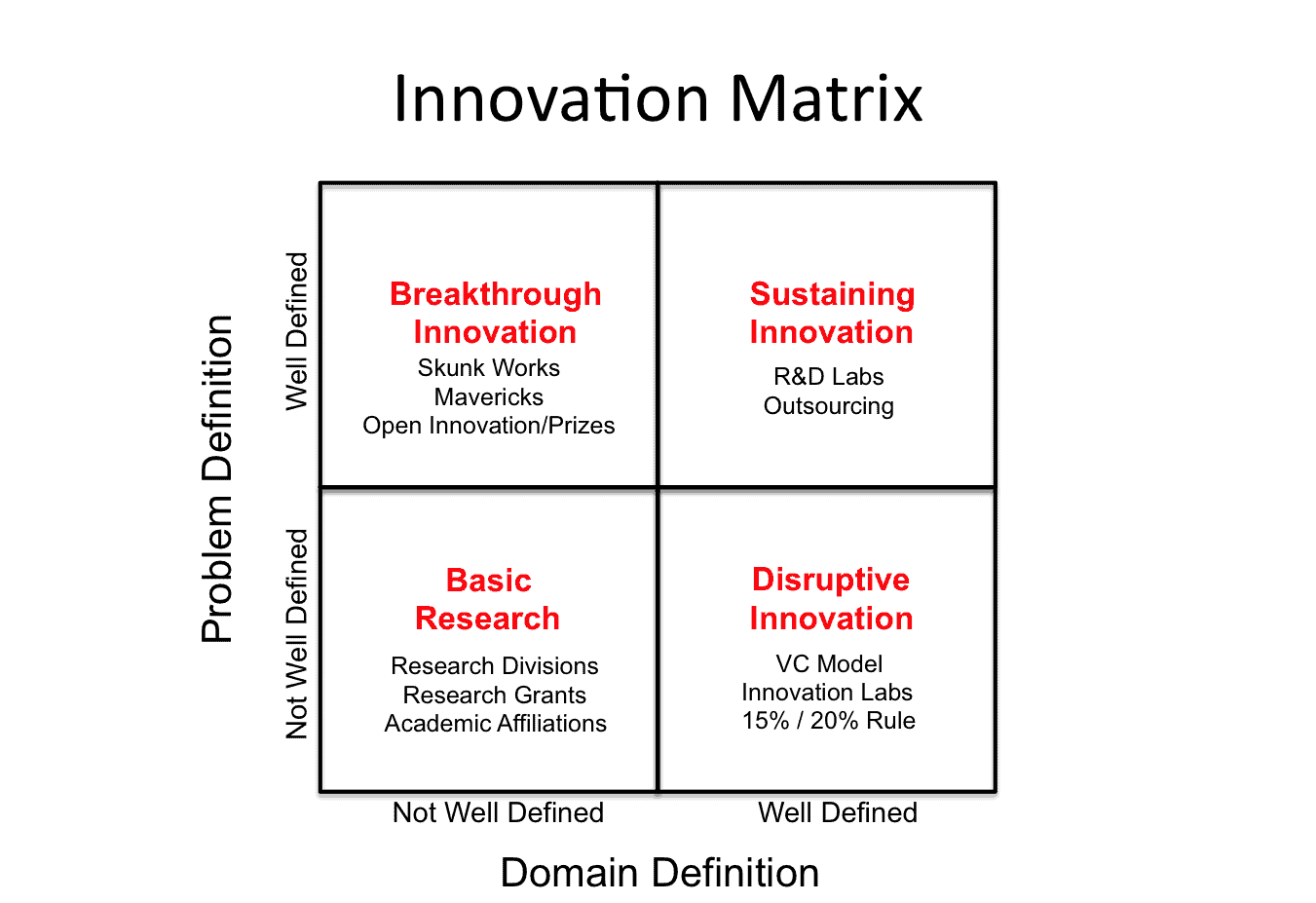
Source : Satell (2015)
The transformation expert Greg Satell (2015) describes four different manners a business can innovate: first of all with basic research, secondly with breakthrough innovation, thirdly with sustaining innovation and finally with disruptive innovation, which are shown in his innovation matrix (figure 1). Innovations can be sorted into 4 categories (figure 1):
a) Innovations resulting from basic research, which is rather executed in public institutes such as state laboratories than in businesses, and are later on used by businesses.
b) Innovation can also be a result of a research for an answer to a specific problem, which is then called a “breakthrough” innovation and can be encouraged with prizes with awards.
c) Sustaining innovation, which is the result of a company creating more performant products with the objective of obtaining higher profits. Sustaining innovation generally comes from industries already performing well in their sector (see also Business Insights Blog, 2022).
d) Disruptive innovation, which happens when a company, often new on the market, gets to a higher position in a given market and challenges an already existing business, taking up segments of this market from already existing companies and leaving those already established ones to give up those sectors and focus on more profitable sectors (rather than fighting for this lost share), and eventually losing the whole market due to obsolete practices or technology. This is thus a “disruptive” innovation, since it upsets markets by putting pressure on companies with obsolete practices, and replacing them with more modern and efficient ones.
In all cases, an innovative solution is a successful idea, often risky. It is a key factor in the competitiveness of industries, and a means of generating growth (MBA Knowledge Base, 2015). These notions of success and added value distinguish it from a simple invention.
The OECD glossary of technical terms describes innovation as “the implementation of a new or significantly improved product (good or service) or process, a new marketing method or a new organisational method in business practices, work organisation or external relations” (OECD glossary, n.d.)
Digitalisation and Covid-19
The Covid-19 crisis has proven to be an accelerator of digitalisation – a key element of the fourth industrial revolution – which was already underway in many companies. Before the health crisis, the dynamics of digitalisation in companies was mainly based on the automation of certain tasks to gain efficiency. The adoption of digital tools resulted in fluidity and simplification, in order to focus on high added-value tasks. This earlier digitalisation was beneficial for companies when the COVID crisis hit. Companies that were committed to digitalisation earlier showed more agility and resilience in the face of the crisis (Eagle, 2020). However, many companies managed to adapt to this trend during the crisis.
Figure 2: Worldwide companies’ digital strategy type

As seen on Figure 2, as a result of the COVID pandemics, according to an estimation, 49% of worldwide IT companies have adopted a digitalisation strategy and are executing it, and only17% have no strategy. This shows how global the digitalisation trend, which is so central in the fourth revolution, is.
Moreover, according to an article published by the World Economic Forum, the modernization of supply chains after the COVID crisis will also rely on the massive and rapid digitalisation of the paperwork that are used in global trade (Lin and Lanng, 2020).
Figure 3: Acceleration of customer interaction digitization (in %)
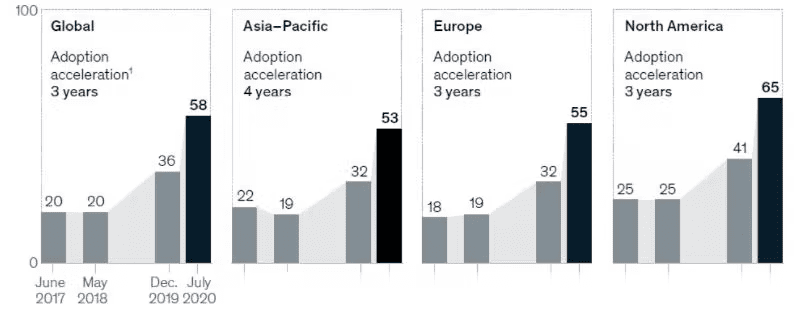
Source : Mckinsey, 2019
Customer interactions are naturally the first to be affected by the acceleration of the digitalisation of companies. During the COVID-19 crisis, consumers had a massive recourse to digital channels to make their purchases, since the majority of physical stores were closed at the time. To meet this demand, many companies had to digitalise their interactions with their customers. In Europe today, the majority of customer interactions (55%) have been digitalised (figure 3). In terms of evolution, the European companies surveyed are at the top of the podium, with an average increase of 71% compared to December 2019. This represents a 3-year advance compared to pre-crisis predictions.
Figure 4: Acceleration of adoption of digitalisation
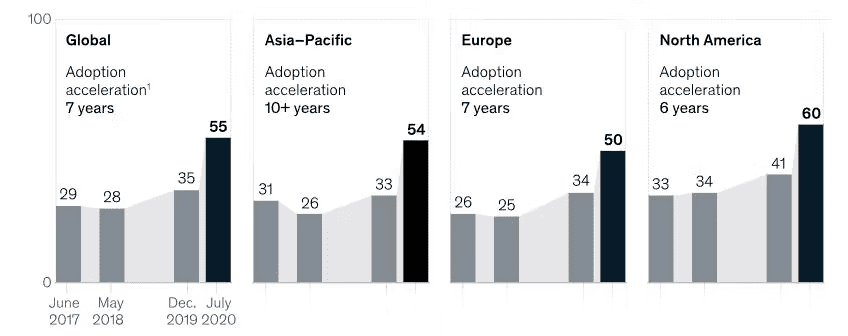
Source: (Mckinsey, 2020)
Logically, the more consumers look for digitalized offers, the more companies try to adapt to the demand. As a result, most companies have increased 7 years from pre-crisis estimates (see figure 4). One of the most visible consequences of the successive lockdowns was the massive adoption of remote working, for those that could. Since then, its generalisation has been so well adopted that it has led organisations to propose hybrid modes of operation between on-site and remote work, even after the lockdowns linked to the COVID crisis.
As well as adding new modern components to our everyday life such as QR codes, the pandemics triggered a large restructuration of traditional models at workplaces and universities. Remote working went from an exception to almost a norm. As seen on figure 5, the percentage of workers in the United States working remotely on full time has gone from 17% to 44%, only in 2020 (Holst, 2020).
Figure 5 : Change in remote work trends due to COVID-19 in the United States in 2020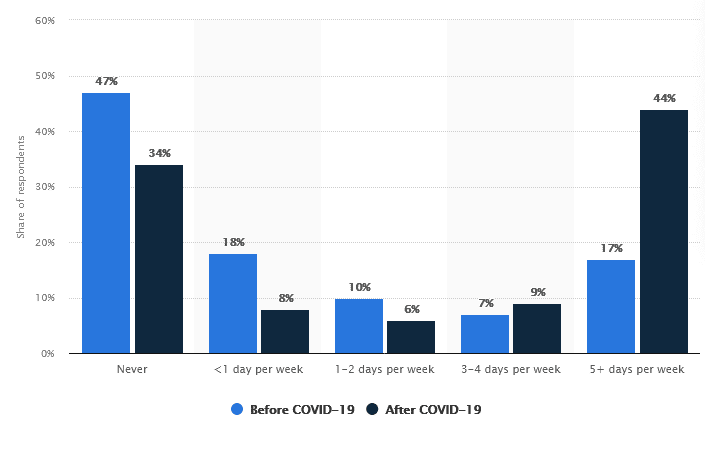
Source : Statista, 2020
Figure 6 : Share of employees who would recommend working remotely to a friend
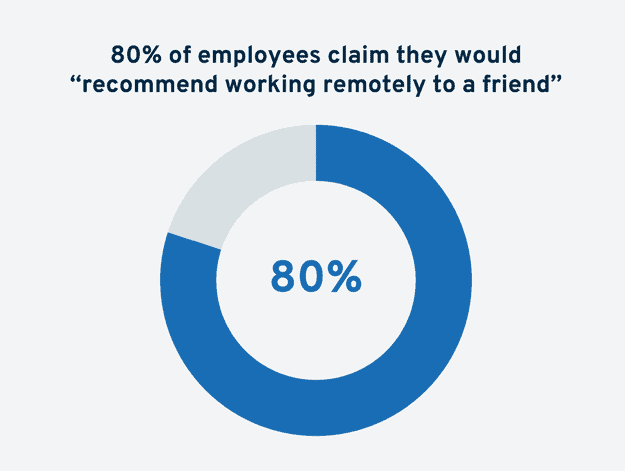
Source : Howarth, 2022
Figure 6 shows that not only such a drastic structural change as remote work was firstly accepted because of constraints, but that it was finally adopted by most for reasons of comfort and habit (Exploding Topics, 2021). In this case, 80% of employees have said to recommend working remotely to a friend, showing that this new habit was not only this new step towards generalised digitalisation was used widely as a way to overcome the COVID crisis, but it was widely accepted and that it is here to stay, assuredly strengthening the global trend towards generalised digitalisation (figure 7). Moreover, as well as remote working, usage of remote meetings also seems to be a lasting trend, as according to a poll by Nature (Figure 6), 81% of respondents think that some meetings should remain online, even after the end of the pandemic.
Figure 7: Businesses spending on Work-From-Home tools
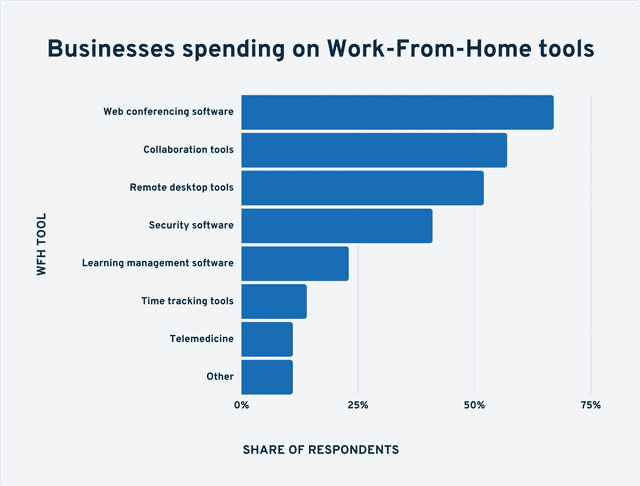
Source : Howarth, 2022
As shown on Figure 7, companies invest mainly in one element in order for home offices to properly function : Web conferencing softwares. Those softwares have made huge gains in usage in the world and have become absolutely necessary for a very large proportion of companies during the COVID pandemics. When observing their evolution in usage during the pandemics, it is clear that Zoom managed to become the most used software by companies thanks to its innovative characteristics that have added to the workplace during pandemics (see Figure 8).
Source: Statista, 2022
Figure 8: Video call platforms’ market share in 2020 vs 2021
![]()
Not only companies have incorporated online meetings as a common internal procedure, but they have also modernised their habits in order to ease the perpetuation of this new habit, by opting for more adapted softwares. Indeed, Skype, which was generally used before the COVID crisis for punctual needs, suffered a -25% decrease in market share, while Zoom gained 22%.The main threat came from google and its Google meet, which also had a spectacular increase of 20% due to the simplicity of connecting Google agenda and Google meet, and proposing a uniformed and standardised platform with all meetings, making it more attractive for entreprises. The COVID crisis forced institutions to stick to one application of choice and get client “loyalty”. It seems that this health crisis has had a relative creative destruction effect with video conferencing calls, selecting the fittest companies (most modern, best services and most practical) and has also forced them to specialise in order to attract different clients (individuals, businesses, schools, universities).
Figure 10: Survey on the percentage of people having attend a virtual conference as a result of the COVID pandemic and the percentage of people who think some meetings should continue to be virtual after the pandemic
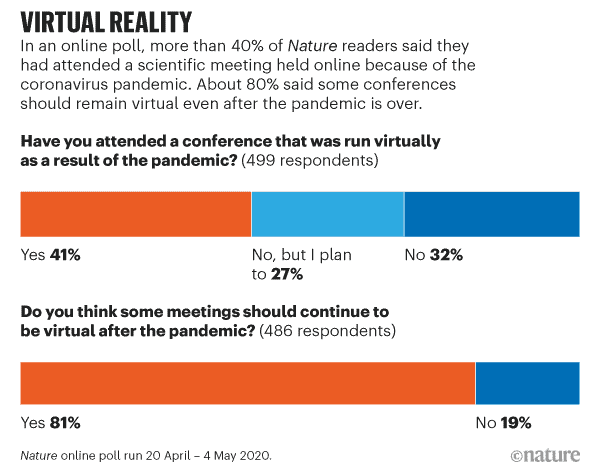
The increased democratisation of internet usage and its improvement in speed and quality allowed for the increased interconnectivity of people and their familiarisation with the digitally connected world. Consumers are now a part of this world of Big data through their cell phone, and as shown above, are getting familiarised with using digital tools in their company. This “democratic” digitalisation is a necessary part in the process of transition towards an economy running on the fourth industrial revolution. The following section will analyse how the Industry 4.0 alters and transfigures the conception of former industries, and how the process of digitization of enterprises and their production process can involve to a large extent consumers themselves, forming a symbiosis between producers and consumers.





